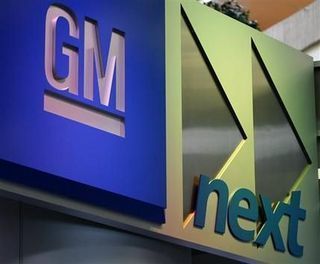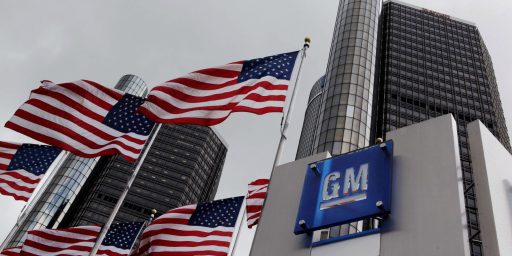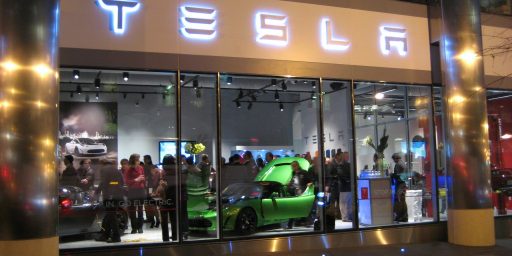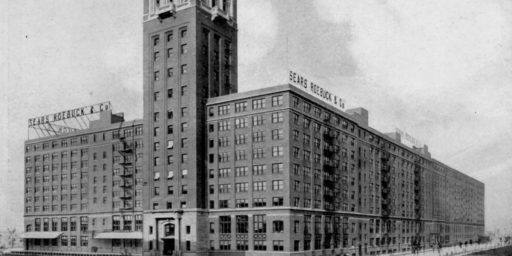GM Bankruptcy Over, GM Lite Emerges
 Surprisingly few bloggers of the bloggers I read are writing about GM’s emergence from bankruptcy in a mere 40 days through a rather unorthodox process. The background:
Surprisingly few bloggers of the bloggers I read are writing about GM’s emergence from bankruptcy in a mere 40 days through a rather unorthodox process. The background:
AP:
General Motors completed an unusually quick exit from bankruptcy protection on Friday with ambitions of making money and building cars people are eager to buy. Once the world’s largest and most powerful automaker, new GM is now leaner, cleansed of massive debt and burdensome contracts that would have sunk it without federal loans.
After a six-week trip through bankruptcy, the “new” General Motors was born Friday owned by the government and free of tens of billions in debt and shed of unaffordable brands, dealerships and plants.
The sale of the valuable assets of the old company to the new GM was completed Friday morning.
[…]
The new company retains the Chevrolet, Cadillac, GMC and Buick brands, along with most of its overseas operations.
GM also keeps about 3,600 of its 6,000 U.S. dealerships and most of its plants. But 14 U.S. plants will be closed, and the company will eliminate about 20,000 of its 88,000 U.S. employees by the end of the year as it continues to cut costs.
While the new company goes forward outside of bankruptcy, much of its debt and many of the assets it shed in the process remain in bankruptcy. It will take about two to three years for an entity known as Motors Liquidation Co. (GMGMQ) to liquidate under court supervision.
NYT:
“It’s just beginning. It’s nowhere near over,” said Keith Crain, the publisher and editorial director of Automotive News, an industry trade publication. Speaking on WJR-AM in Detroit, Mr. Crain said, “They’re going to need hard work, a lot of smarts, and they’re going to need good luck.”
G.M.’s goal, said the chief executive, Fritz Henderson, is to design, build and sell the best vehicles in the world, something that the company had forgotten.
“We deeply appreciate the support we’ve received during this historic transformation and will work hard to repay the trust and the money that so many have invested in G.M.,” Mr. Henderson said hours after the company closed the sale of its good assets to a new, government-backed carmaker.
While Friday marked the first day of the new G.M., many unanswered questions remain, including the government’s role at the company. The federal government will hold nearly 61 percent of the new company — now called the General Motors Company — with the Canadian government, a health care trust for the United Automobile Workers union and bondholders owning the balance. By the end of the year, the government will have poured $50 billion of taxpayer money into the automaker.
[…]Senior administration officials have promised that they will not micromanage the company, despite being the majority owner and having already picked new directors, including G.M.’s new chairman, Edward E. Whitacre Jr.
The administration hopes to take the new G.M. public again next year.
CNN’s report that the bad assets will continue to go through something akin to the traditional bankruptcy process is encouraging news that I hadn’t seen elsewhere. The idea that a massive corporation could simply sell its “good” assets to itself while leaving its debt entirely behind struck me as outrageous. It remains to be seen what its creditors get; they’re certainly entitled to something.
Rolfe Winter makes the most obvious point:
Remember when everyone was saying that if GM filed for bankruptcy the world would end? It didn’t. Yeah they got lots of government help, but they were still able to divest billions of old liabilities. So why don’t we remove the bailout facilities benefiting banks and busted homeowners and force them through the bankruptcy process?
Especially if it’s the new, pain-free bankruptcy that doesn’t ruin your credit for seven years.
Jim Manzi, Kevin Drum, and Matt Yglesias are upset with the notion that the government might intervene to keep the automakers from unilaterally closing 2000 dealerships. But, considering that the government actually owns GM and is backstopping Chrysler to the tune of billions of dollars, I’m not sure why they shouldn’t intervene. Especially given that the process by which these franchises were closed was, to say the least, opaque.






Dunno why. As I see it, the Feds mandated, as part of the aid they recieved prior to bankruptcy, that GM and Chrysler cut dealerships. The only problem was that those dealerships (privately owned companies of 70-120 employees)were found to donate a lot of $$$ within communities (sponsors of little leage baseball, soccer, etc.) not to mention the unease of the added layoffs and the problems for state reps in Washington. Oddly, there was a sudden reversal that they didn’t need to cut more dealerships.
So at this point, closing any dealerships would give the appearance that it was via the heavy hand of the Feds. It’s pure politics.
Well, the intervention in the dealership closing is simply proof that the companies will not be operated free of meddling by the government. So new investment by those not as powerful as the government or the UAW is a fools errand. If the companies do something in the corporate interest that isn’t liked by the big powerful “investors” then the little investor is screwed.
Many of us without billions, tag along with the big investors who can influence decisions in operating their investments but we do so with the assumption that influence will be to increase the value of the investment. The government and the UAW
may notprobably won’t influence to increase return or even to strengthen survival of the company. Their investment strategies are not to make money but to pursue agendas divorced from market realities.AFAIK Chrysler and G.M. never gave a really sound business reason for cutting the dealerships, nor did they ever disclose the methodology used.
A large part of the problem though is that by the time the cuts were being made, the government was already involved and the automakers and their czar were being lobbied on which dealerships to save.
My preferred approach would have been to use bankruptcy to set new performance standards for the dealerships. Those dealers that didn’t like the new standards or couldn’t meet them, could close and then file a claim in bankruptcy for any resulting financial obligation.
One of the tenets of a successful economy is the protection of property rights. We can se scores of examples of unsuccessful economies around the world where property rights are protected, no success stories where property rights aren’t protected.
Given the way the government has handled the property rights of the investors and creditors of GM, why would anyone put money into a business that had a democratic client (like the UAW) that could benefit from your money being stolen.
It is hard to pick which action by Obama will have the longest negative impact on the US, but the trampling of property rights for political expediency has to be in contention.
“My preferred approach would have been to use bankruptcy to set new performance standards for the dealerships. Those dealers that didn’t like the new standards or couldn’t meet them, could close and then file a claim in bankruptcy for any resulting financial obligation.”
Posted by PD Shaw
That would have been a good way. The only thing I’d change is to judge them on the past decade’s performance, under the assumption that GM doesn’t have years to waste.
I have been wondering myself, and I still am. The deal was forced through by the government, and the government emerges as the major owner, which ought to raise a lot of eyebrows.
See my blog post of yesterday.
Even if the New GM works as a company it won’t work as an investment for the 300 Million US shareholders. Here is the scary math behind our little investment.
The government effectively will get 60% of General Motors in exchange for $50 Billion in aid.
This, using standard investor math, means that GM has an implied value of:
50 Billion/.60 = $83.3 Billion
Currently (just prior to bankruptcy) GM had 610 million shares outstanding.
That means that for the taxpayer to break-even GM shares (in the pre-bankruptcy world) would need to be worth $136.55 PER SHARE (83.3 Billion/610 Million)
The lifetime HIGH for GM is $93.62 back in April 2000 when the going was good. So good luck with that.
Oh and to complicate matters the government will see its holdings diluted if the bondholders take the extra 10% that they were promised as part of setting up the bankruptcy filing. If GM is doing well one would assume they would exercise these options and taxpayer shareholders would get diluted.
In that case the taxpayer stake goes to 54% which means an assumed market cap of $89.3 Billion or a per share price of $146.39
So even if GM were to return to its lifetime high of $93.62 the taxpayer would only get back $34 Billion 0r 68% of its investment if GM got as BIG as it ever was.
This of course is impossible based on the Government’s own admission that they are structuring GM to compete in an economy where car sales are 33% less than they are now.
Sure these numbers are approximations and some of the debt might be repaid like a normal loan (and I hope most of it is) but you can tell that there is no way that the taxpayers will see even HALF of their money returned even if all the right things happened (in a short-period of time as President Obama doesn’t want to hold on for long).
Well look on the bright side. We got rust-protection and under-coating free with the deal and we know how important those are.
http://watchingmarcitz.com/2009/06/01/the-scary-math-behind-the-gm-taxpayer-bailout/